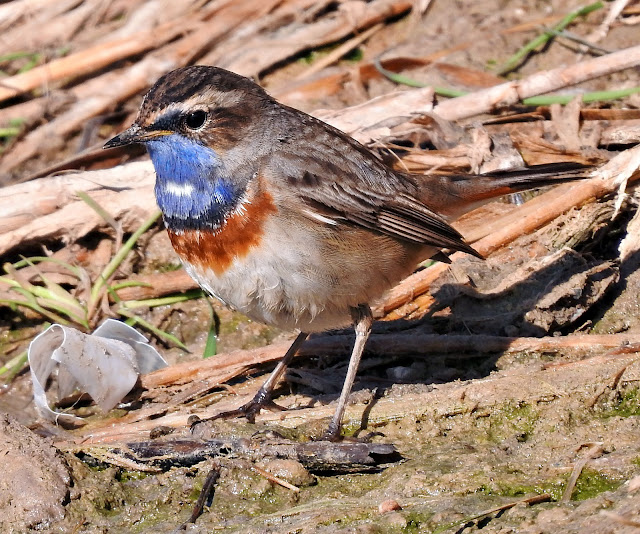The bluethroat (Luscinia svecica) is a small passerine bird that was formerly classed as a member of the thrush family Turdidae, but is now more generally considered to be an Old World flycatcher, Muscicapidae. It, and similar small European species, are often called chats.
It is a migratory insectivorous species breeding in wet birch wood or bushy swamp in Europe and across the Palearctic with a foothold in western Alaska. It nests in tussocks or low in dense bushes. It winters in the Iberian Peninsular, the northern half of Africa, and in southern Asia (among others including the Indian subcontinent).
The bluethroat bird is similar in size to the European robin at 13–14 cm. It is plain brown above except for the distinctive black tail with red side patches. It has a strong white supercilium. Despite the distinctive appearance of the males, recent genetic studies show only limited variation between the forms, and confirm that this is a single species. Moults begins in July after breeding and are completed in 40–45 days, before the birds migrate.
The male has a varied and very imitative song. Its call is a typical chat chack noise.
Females of all subspecies usually have just a blackish crescent on an otherwise cream throat and breast. Newly fledged juveniles are freckled and spotted dark brown above.
The genus name Luscinia is Latin for the common nightingale. The specific epithet svecica is from Neo-Latin Suecicus meaning "Swedish". The colours of the male's breast were thought to evoke the Swedish flag, the yellow in the flag being more orange hued.
Females of all subspecies usually have just a blackish crescent on an otherwise cream throat and breast. Newly fledged juveniles are freckled and spotted dark brown above.
The genus name Luscinia is Latin for the common nightingale. The specific epithet svecica is from Neo-Latin Suecicus meaning "Swedish". The colours of the male's breast were thought to evoke the Swedish flag, the yellow in the flag being more orange hued in the 17th and 18th centuries.
The bluethroat (Luscinia svecica ) is a small passerine bird that was formerly classed as a member of the thrush family Turdidae, but is now more generally considered to be an Old World flycatcher, Muscicapidae. It, and similar small European species, are often called chats.
It is a migratory insectivorous species breeding in wet birch wood or bushy swamp in Europe and across the Palearctic with a foothold in western Alaska. It nests in tussocks or low in dense bushes. It winters in north Africa and the Indian subcontinent.
The bluethroat is similar in size to the European robin at 13–14 cm. It is plain brown above except for the distinctive black tail with red side patches. It has a strong white supercilium. Despite the distinctive appearance of the males, recent genetic studies show only limited variation between the forms, and confirm that this is a single species. Moults begins in July after breeding and is completed in 40–45 days, before the birds migrate.
Bluethroat, (Erithacus svecicus or Luscinia svecica), Eurasian chat-thrush of the thrush family, Turdidae (order Passeriformes). The bluethroat is aobut 14 centimetres (5 1/2 inches) long and has a bright blue throat, incorporating a crescentic spot of red or white, depending on the subspecies. Found from western Europe eastward to western Alaska, the bluethroat is essentially a bird of damp thickets in mountains, but in western Europe it occurs in lowlands also. It has a rich, varied, warbling song.
A small Robin-like bird, the male is unmistakable in spring with his bright blue throat, bordered below with bands of black, white and chestnut. Its central throat spot can be white or chestnut, depending on which subspecies you are looking at 'white-spotted' or the more numerous 'red-spotted'. They can be quite secretive, flicking into the cover of a bush with a flash of their chestnut tail patches.
Bluethroat breeds on tundra with brushy areas, thickets, wet forest edges, scrubs on hills and mountainous areas, often near water. This species needs low dense vegetation for nesting.
It may be found up to 2600-3800 metres of elevation in Afghanistan and NW Himalayas.
It winters in scrubby waterside and reedbeds.
Bluethroat breeds in northern Europe, Eurasia, western Alaska and Yukon Territory.
It winters mainly from north eastern Africa to western India, and in sub-Saharan Africa, from Gambia to Ethiopia, and Saudi Arabia.
Winter areas in North America are unknown, but the species presumed to winter in SE China, crossing the Bering Strait.
Bluethroat is an insectivore. It forages in low vegetation to catch insects. When on the ground, it turns over the leaves and the soil to expose small invertebrates. It may hawk flying insects too. It runs on the ground as a mouse. It remains hidden under cover. It has an erect attitude and may stay motionless for a moment.
In winter, we can see it hopping at water’s edge among reeds and bushes.
The male sings from an exposed perch, at the tip of a branch of small scrub. The female is shyer and secretive. During the courtship displays, the male often sings while performing flight displays. It also fans its tail to expose the reddish feathers to the female.
It also guards its mate from other males around the start of the egg laying. It stays within one metre of her, and follows her when she leaves the nest. Copulation occurs under cover of vegetation.
They are territorial, but the boundaries between territories seem to be very flexible.
The species is monogamous, although polygamy has been observed and also extra-pair copulations.






















%20(Luscinia%20svecica%20ssp.%20cyanecula)%2020.jpg)
%20(Luscinia%20svecica%20ssp.%20cyanecula)%2021.jpg)